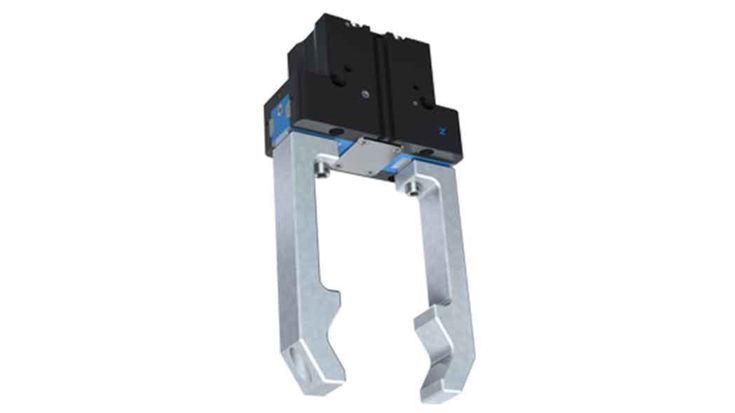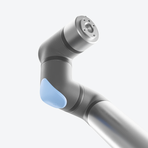Pneumatic and hydraulic grippers are amongst the most popular gripper types (along with servo-electric). If you're wondering whether pneumatic or hydraulic grippers are likely to be the best fit for your application, this article is for you as we compare and contrast the design, performance and usability of hydraulic and pneumatic grippers.
Industrial gripper showdown: pneumatic gripper vs. hydraulic gripper

Pneumatic and hydraulic grippers are amongst the most popular gripper types (along with servo-electric). If you're wondering whether pneumatic or hydraulic grippers are likely to be the best fit for your application, this article is for you as we compare and contrast the design, performance and usability of hydraulic and pneumatic grippers.
Spoiler: As showdowns go, this one is easy to call. We'll soon discover that for collaborative robot applications, there is no serious competition between the two: pneumatic grippers are the ideal choice for your cobot-powered applications.
Let's find out why...
What is a hydraulic gripper?
Hydraulic grippers are heavy-duty grippers that apply the type of forces required to handle heavy (usually >50kg, 110.23 lb) items.
How does a hydraulic gripper work?
Hydraulic grippers use pressurized fluids to move a piston. When the piston moves, it transfers this force to the claw, opening and closing it.
What is a pneumatic gripper? How does a pneumatic gripper work?
Pneumatic grippers use pressure from a compressed air supply system to supply the power required to move an inner piston, thereby opening and closing the pneumatic gripper fingers (or 'jaws'). Pneumatic gripper mechanisms contain no motors or gears, which makes it easy to translate the power of a piston/cylinder system into a gripping force.
Since the majority of manufacturing facilities already have access to compressed air, deploying pneumatic grippers is easy and cost-effective. One of the main benefits of pneumatic grippers is that they provide a high amount of gripping force in a small, light and low-cost package. For manufacturing facilities where space is at a premium, pneumatic grippers are an economical and ergonomic choice. They are also quite easy to maintain –once you have your pneumatic gripper working, it can provide millions of cycles without requiring maintenance.
What is the difference between pneumatic and hydraulic grippers?
One of the primary reasons why hydraulic grippers are rarely, if ever, used in collaborative automation is because the typical payloads don't match. For reasons of safety, ease of deployment, cost, mobility and footprint, cobots are designed for lower-than-hydraulic payloads of up to around 16kg (35.3 lbs). Therefore, for almost every conceivable cobot-powered application, using a hydraulic gripper would be expensive overkill.
If you need to lift weights of 500kg (1102.31lb), for example, a standard industrial robot with a hydraulic gripper and fencing might be the best choice. But for Universal Robots customers, pneumatics offer perfectly adequate energy density for applications such as assembly, material handling and machine tending.
Additionally, since hydraulic grippers contain pistons and oiled parts, they are much higher-maintenance than their servo-electric and pneumatic counterparts. Hydraulic gripper maintenance is also complex and can require skilled technicians to maintain the oil, pump and reservoir. This highlights another important reason why pneumatic grippers tend to be preferred over hydraulic grippers for collaborative applications: cobots are designed for easy operation by non-expert end-users, so adding a complex hydraulic gripping system to a cobot will undermine the overall system's ease of use.
Since they rely on air rather than fluids, pneumatic robot grippers can be deployed in clean room environments. By comparison, hydraulic robot grippers are too messy –especially when they fail and leak hydraulic fluid into your work cell.
Furthermore, in terms of cost, hydraulic grippers are much more expensive than their pneumatic counterparts. If you are attracted to cobots in part because of their low cost compared to traditional automation, then it doesn't make a lot of sense to deploy a hydraulic gripper that could easily cost more than the cobot itself.
Finally, if accuracy is important to your collaborative application, then keep in mind that pneumatic gripping systems provide greater accuracy than their hydraulic counterparts. Your gripper's URCap software and easy integration with Universal Robots cobot range ensures a constant flow of data that can be used to tweak your applications and processes, reduce downtime and improve productivity.
URCaps are special software programs designed to ensure smooth programming and control of UR certified end-effectors and components. UR+ is a global ecosystem of components, software, and application kits that have been validated and certified to be mechanically, electrically and digitally compatible with cobots from Universal Robots. UR+ hosts a wide selection of pneumatic grippers from you to choose from.
Pneumatic grippers easily win this robot gripper showdown, but they have their own limitations. For example, because they rely on pressurized air flow, force control is not as precise as that provided by electric grippers. Providing a delicate grip can also be a challenge for pneumatic systems since it’s hard to control the gripper at very low pressures. If an external air supply is required, this can add extra cost to your deployment. And while pneumatic grippers are suitable for many clean room applications, if they fail, they can contaminate the air inside the work cell. For these reasons, some manufacturers prefer to use electric grippers for their material handling needs.
UR+ is a one-stop-shop for pneumatic robot grippers
Let's take a look at some of pneumatic robot gripper options available through UR+
The GRIPKIT-P Series from Weiss Robotics is a pneumatic gripper and handling system for Universal Robots. The GRIPKIT-P system contains everything end users need to set up material handling, assembly and machine tending tasks within minutes. If you need high dynamics and gripping force with compact dimensions, GRIPKIT-P pneumatic grippers (in parallel or centric design) are ideal.

SCHUNK offers an extensive range of UR-certified pneumatic grippers through the UR+ ecosystem. For example, SCHUNK's Gripper for small components (KGG 100-80) is a narrow 2-finger parallel gripper with long stroke that's ideal for use in clean environments. The long-stroke gripper (PSH 22) is a rugged, 2-finger parallel gripper with long jaw stroke that's designed for use in contaminated work environments. One of SCHUNK's most popular grippers is its Universal gripper PGN-plus-P –a 2-finger parallel gripper with permanent lubrication, large gripping force and high maximum moments thanks to multi-tooth guidance. This gripper is designed for handling workpieces in clean to slightly dirty environments. Also popular is SCHUNK's Universal gripper JGP –a compact 2-finger parallel gripper with T-slot guidance. This gripper is designed for use in many applications and environments and can be deployed in both clean and slightly dirty environments. For applications with special temperature, dirt and chemical resistance requirements, the Universal 3-Finger Centric Gripper is a good fit, plus, it has a high gripping force.

The Zimmer Group offers a wide range of UR-certified pneumatic grippers, including 2-jaw parallel-, 3-jaw concentric,- 2-jaw angular-, internal- and magnetic grippers as well cutting tongs. The series provides gripping forces from 30N for delicate operations to more than 2,000N for heavy-duty applications. Zimmer's 2-Jaw Parallel Gripper GPP5000 –Pneumatic, for example, combines powerful gripping, long gripper jaws and corrosion protection. An optional self-locking mechanism ensures safe gripping even in the event of power failure or E-Stop.

The Zimmer Group has also developed a series of 'hybrid grippers' for UR cobots that combine features of electric and pneumatic systems. While many pneumatic gripping systems on the market require external valves to control the flow of air to the gripper, Zimmer's hybrid gripper series comes with an integrated valve to control air flow. It also comes with integrated sensors that provide a measurement resolution of ±0.05mm and enable the gripper to understand the forces it is applying to the object being handled.
Zimmer's 2-Jaw parallel gripper series GPP5000IL and its 3-Jaw Concentric Gripper GPD5000IL, for example, are robust grippers specially developed for use in demanding environments. Both come with URCap software that's fully integrated with the UR teach pendant, making coding and control a breeze, even for those with little or no prior hands-on robotics experience. Both types of pneumatic gripper promise up to 30 million cycles without requiring maintenance and both use IO-Link to provide bidirectional communication for process-data and service-data.


- Universal Robots USA, Inc
- 27175 Haggerty Road, Suite 160
- 48377 Novi, MI